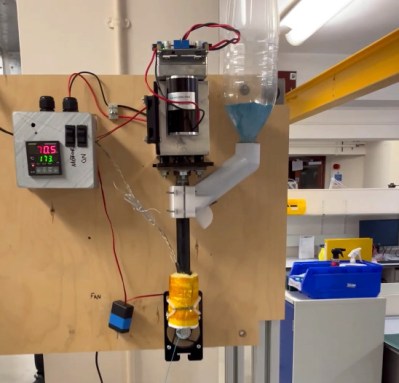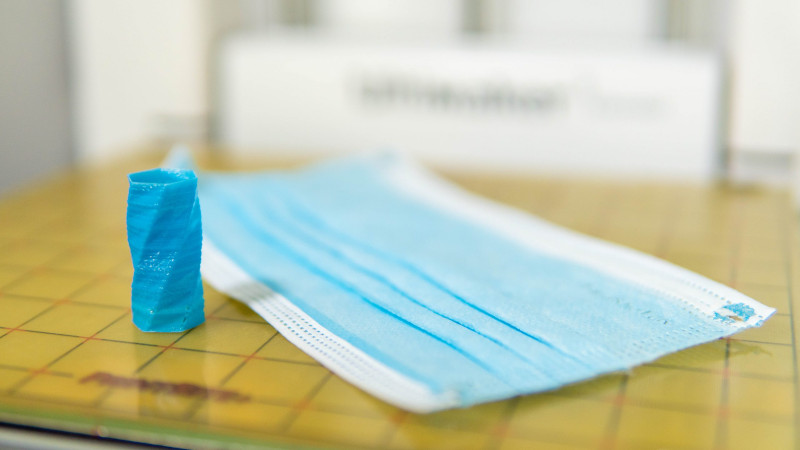Disposable masks have been a necessity during the COVID-19 pandemic, but for all the good they’ve done, their disposal represents a monumental ecological challenge that has largely been ignored in favor of more immediate concerns. What exactly are we supposed to do with the hundreds of billions of masks that are used once or twice and then thrown away?
If the research being conducted at the University of Bristol’s Design and Manufacturing Futures Lab is any indication, at least some of those masks might get a second chance at life as a 3D printed object. Noting that the ubiquitous blue disposable mask is made up largely of polypropylene and not paper as most of us would assume, the team set out to determine if they could process the masks in such a way that they would end up with a filament that could be run through a standard 3D printer. While there’s still some fine tuning to be done, the results so far are exceptionally impressive; especially as it seems the technique is well within the means of the hobbyist.

The first step in the process, beyond removing the elastic ear straps and any metal strip that might be in the nose, is to heat a stack of masks between two pieces of non-stick paper with a conventional iron. This causes the masks to melt together, and turn into a solid mass that’s much easier to work with. These congealed masks were then put through a consumer-grade blender to produce the fine polypropylene granules that’re suitable for extrusion.
Mounted vertically, the open source Filastruder takes a hopper-full of polypropylene and extrudes it into a 1.75 mm filament. Or at least, that’s the idea. The team notes that the first test run of filament only had an average diameter of 1.5 mm, so they’re modifying the nozzle and developing a more powerful feed mechanism to get closer to the goal diameter. Even still, by cranking up the extrusion multiplier in the slicing software, the team was able to successfully print objects using the thin polypropylene filament.
This is only-during-a-pandemic recycling, and we’re very excited to see this concept developed further. The team notes that the extrusion temperature of 260 °C (500 °F) is far beyond what’s necessary to kill the COVID-19 virus, though if you planned on attempting this with used masks, we’d imagine they would need to be washed regardless. If the hacker and maker community were able to use their 3D printers to churn out personal protective equipment (PPE) in the early days of the pandemic, it seems only fitting that some of it could now be ground up and printed into something new.

















What exactly are we supposed to do with the hundreds of billions of masks that are used once or twice and then thrown away?
A better question might be how can you separate them from the waste stream. I’d venture to say the vast majority of those hundreds of billions of masks are tossed in the trash and end up in a landfill.
It’s probably not worth the trouble to remove the cat poop and spoiled food that has seeped into them, nobody wants stuff that smells like a landfill.
Unfortunately a large number of them are ending up in the ocean 1) People are litterbugs 2) Even if disposed of in public trash cans, they are very lightweight and can easily be blown out.
Can the technique be applied to polyester clothing? It would be great to throw old clothes in the hopper and turn them into something useful.
This idea is completely nuts. Used masks are hazardous waste just like diapers, cat poop and dead rats. To make 1 kg of filament you need to pick about 500 masks from household trash, rip off the ear bands, remove the nose wire, wash them, etc. This probably needs more energy and other resources than producing fresh filament, including raw materials. The best way to get rid of them is to use them as incinerator fuel instead of oil or gas.
Agreed. This is a gimmick.
It’s an attempt at solving an issue.
Got a better idea? Suggest it. Otherwise you folks are just complaining about someone trying to make the world a better place.
Not all ideas are good ideas and this is certainly not a good one. Biohazard waste is incinerated for good reason.
The mechanics of this build are well done so maybe finding another source of the material that isn’t considered medical waste it could be useful.
oh, are they asking people to send them masks?? i didn’t realize, I thought this was just a good way to recycle your own??
Oh are they asking strangers to send them masks?? I didn’t realize. I thought this was just a great way to recycle your own masks?
And nobody else will ever come close to this filament? I’m willing to accept that once it’s been through a printer’s nozzle, it’s likely to have been heat-sterilized, but unless the masks, granules, filament extruder, and everything else involved prior to that are sterilized, it all should be considered either biohazardous waste or contaminated items.
By that logic all worn clothing and any item potentially exposed to human breath is medical waste too.
Masks being medical waste was stated by the comment that started off this subthread. I was responding to a comment that seemed to imply that there were no problems as long as they were your own masks being recycled, which I think is a defensible position only as long as any organisms that accumulated in the masks are (relatively) harmless, unable to survive the recycling process, or nobody else gets exposed to it until it’s gone through some sterilizing process.
If masks aren’t medical waste, then there’s likely no real problem with non-sterile recycling of them into filament.
As for other clothing, you have a point, but I don’t consider it pertinent. We’re discussing recycling masks meant to prevent transmission of a respiratory disease. If we were discussing recycling clothing while dealing with a disease transmitted via perspiration, skin flakes, or something similar, your comment would be more applicable.
It’s not biohazardous waste if you’re allowed to throw it in any trashcan. Also, viruses can only survive a limited time on the mask, so if properly stored after use for the appropriate time, then this is perfectly safe to do to your own / household’s masks
“The best way to get rid of them is to use them as incinerator fuel instead of oil or gas.”
The better idea was right there in the first post.
Doing a bad job at “making the world a better place” is worse than not doing anything.
As we say in french “l’enfer est pavé de bonnes intentions”.
we say that in english too, just with fewer accent marks
Hartl did suggest a better idea: burn the old masks as fuel. Burning old masks would be better than digging up more oil (assuming the old masks are burned hot and clean etc!)
A) Proof of concept. Does it provide a serviceable material? If so, commercial scale collection could possibly be done with dedicated bins. Of course, there is already recycling of somewhat similar waste in some medical settings, namely the blue wrap from instrument trays.
B) Hackers are presumably generating waste of their own, and need not necessarily collect those from others. One can set the material aside for several weeks to allow any contagions to degrade, and/or put them in a disinfectant bath. The heat from the iron should also help sterilize the material. https://www.med-technews.com/news/medtech-materials-and-assembly-news/cardiff-based-firm-develops-device-to-recycle-ppe/
You’re new to this site, right?
These are already widely recycled. In the UK places like WILKO are collecting used masks in stores to recycle into plastic boards. There’s also a company in France using old facemasks from collection bins to manufacture new PPE. I agree that 3D printing is a gimmick, but being more conscious about plastic waste is not. Burning plastic is a cause of air pollution and not to mention toxic to most living things.
I think this post is an example of what is possible if the attitudes towards recycling change, in particular single use plastics. What needs to be addressed is how plastic waste is collected (not just from PPE) so that it doesn’t go to waste. Have a look at the precious plastics company https://preciousplastic.com/ – they sell a range of machines for small scale plastic recycling and share their work to help create an alternative global recycling system.
i meant 180 degree…
damn you german keyboard layout!!!11eleven
How do yo kill what is not alive ???
Technically it is denaturing/deactivating the RNA in the virus is made of deactivating the virus. but for the purpose of the average Joe Citizen who at best paid next to no attention in biology kill is a term they can grasp.